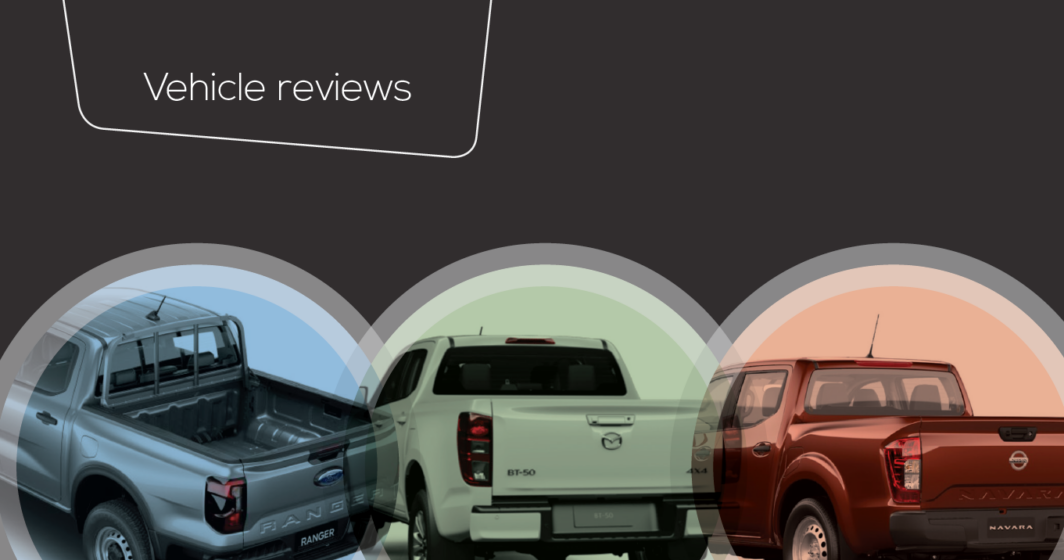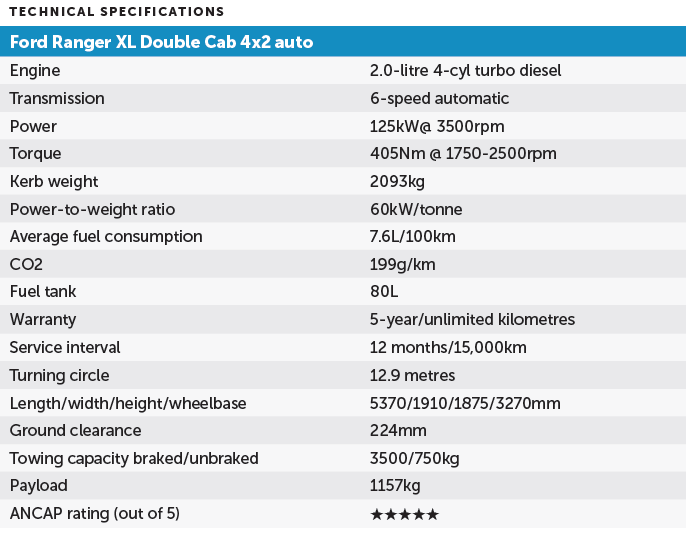Byron Mathioudakis rates his favourite trio of no-frills, family-friendly, dual-cab workhorse utes complete with style and verve.

The Contenders:
| Ford Ranger XL Hi-Rider 4×2 auto Double Cab from $42,580 (before on-road costs) |
Mazda BT-50 XS 4×2 auto Dual Cab from $44,310 (before on-road costs) |
Nissan Navara SL 4×2 auto Dual Cab from $42,100 (before on-road costs) |
 |
 |
 |
Back in the early 1930s, a Victorian farmer’s wife wrote to Ford and General Motors pleading for a vehicle civilised enough for church on Sundays yet still capable of carting pigs to market on Mondays.
At the time, banks would lend money for a farm truck but not a passenger car. Time to blend both.
Shockingly, both companies obliged, though Ford was (just) first. The concept evolved over the decades with Holden and Falcon utes becoming a staple of work and popular culture, with their one-tonne midsized-truck successors carrying the legacy on today.
We look at three of our favourites, in affordable, hose-down vinyl-floorshod built-for-business base-model formats with four doors and five seats, to see how they shape up.

In all the important ways, what makes the 2023 Ranger Wildtrak a class leader also applies to the lowly XL. Though sourced from Thailand like the other dual cab utes here, all T6.2-based utes (and Everest SUV) are alone in being designed and engineered in Australia from the ground-up, making them uniquely suitable to local conditions as well as buyer tastes.
This is obvious from the get-go, with light yet positive steering, suspension that copes with our bad roads with ease while providing pleasing ride comfort, and reassuring control at speed. That’s partly due to driver-assist safety technologies tuned for our roads, that don’t over/underreact as in most other utes.
Likewise, the new 2.0-litre four-cylinder diesel engine/automatic-only powertrains are extensively calibrated for our conditions. The 125kW/405Nm Single-Turbo six-speed auto version has enough
power and torque for most needs, making it a solid performer, though we’d recommend the Bi-Turbo with a 10-speed auto if you need extra muscle to take advantage of all Rangers’ 3500kg towing capability.
Last year’s redesign has brought a much more contemporary interior to match the modern styling outside, building on the Ford’s established strengths of class-leading space, seat comfort and storage practicality. Now, even the base XL looks smart inside, with its large portrait touchscreen, clear digital instrumentation and contrasting textures.
The same applies out back, with its ample room and best bench of the trio by some margin, though the lack of air vents, cupholders, USB ports and overhead lighting smack of penny-pinching. You’ll need to jump up to XLT for most of these - along with LEDs if you don’t want the old-fashioned halogen headlights.
At least the XL doesn’t scrimp in other areas of safety, and includes nine airbags, autonomous emergency braking (AEB), adaptive cruise control, blind spot warning and rear cross-traffic alert
(RCTA) tech.
Finally, larger than before and now with Euro-palette carrying capability, the XL’s tub is alone among this trio with side-wall cappings, an integrated box step and tailgate lift-assist.
The most car-like of the lot, the base Ranger brings all the essentials with commanding confidence.

—

Launched in 2020, today’s third-generation BT-50 broke a 48-year bond with Ford, relinquishing the Aussie-developed T6 Ranger roots of the preceding model for fresh ties with the equally-new Isuzu D-Max.
In terms of exterior design, interior presentation and safety specification, the change elevated the D-Max/BT-50 fraternal twins to new heights amongst medium one-tonne pick-ups. Swapping out the Isuzu’s aggressive looks for a more car-like nose, the BT-50 forges its own visual identity outside, while a similar theme carries through inside too.
Like the Ranger, the Mazda’s front seats are comfy, it’s easy to find the right driving position, the analogue/digital instrumentation mix is comprehensive and there’s lots of storage. However, the Bluetooth quality is questionable and the central touchscreen too small and fiddly in lower grades.
There’s also less space inside compared to Ranger, and the back seat is not quite as accommodating. Though the base XS does at least include face-level air vents and USB/12V outlets.
The auto-only SX lags is in performance. While adequate for most everyday driving, the 1.9-litre turbo-diesel lacks the necessary muscle for effortless towing, and is prone to coarseness. Our suggestion is to stretch to the XT and its 140kW/450Nm 3.0-litre TD. Well worth the extra $3000 or so, and the ute is better equipped to boot.
Finally, while better than most, the Isuzu/Mazda cannot match the Ranger for steering feedback, handling precision or ride quality, and can seem cumbersome in comparison. On the other hand,
while not quite as big out back, the tub is still large and useful enough.
And all grades include AEB, lane departure prevention, blind spot warning and RCTA.
Availability and renowned aftersales service are further areas where the BT-50 shines. If you like what you see, go for it.

—

It might be one of Australia’s oldest utes, but the Navara nevertheless remains highly competitive, benefitting from several updates since launching in 2014 - including a substantial facelift in 2021.
That brought a larger tub and stronger axle to boost payload and improvements to safety, steering and noise suppression.
Behind the latest, bluff nose is a 2.3-litre diesel, available in either 120kW/403Nm single-turbo six-speed manual (now a dying breed so good on you, Nissan) or 140kW/450Nm twin-turbo seven-speed auto.
Both are strong performers, but the auto’s extra punch and refinement are obvious across all driving conditions. It’s also quieter now than before.
The Navara is unique here offering coil-sprung rear suspension instead of leaf springs. The result is decent body control, especially over gravel at speed. That said, while noticeably better than previous versions, the Nissan’s ride comfort remains inferior to Ranger’s. And nor is its steering and handling as involving or precise. In fact, the SL is the dullest of the trio to drive.
Stepping up inside, the (surprisingly car-like) dash screams mid last decade in its dated design, but - aside of having no reach-adjustment for the steering - functionality and practicality remain strong points, with easy-reach controls, clear instrumentation, and storage aplenty.
Plus, all expected amenities to match the others are present - including a rear camera, Apple CarPlay/Android auto, Bluetooth telephony with audio streaming, and most driver-assist safety tech like AEB. And the Navara beats Ranger with face-level air vents, a folding armrest and cupholders out back, though there’s less space and the seats aren’t as comfy.
Still, significantly more grunt for less money means the Navara auto makes sense as the sensible budget option, while keeping the reassurance of Nissan’s 68-year heritage building tough and
dependable utes. If you don’t mind its advancing years.

Share this Article






